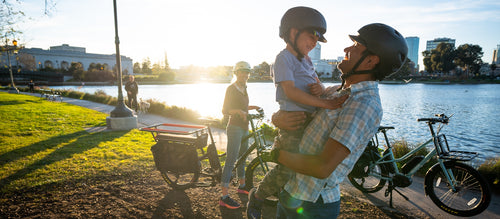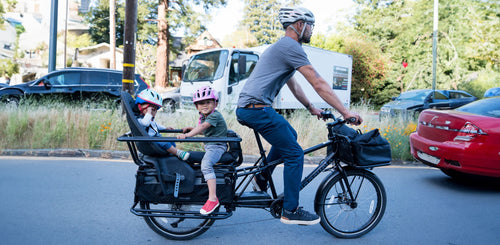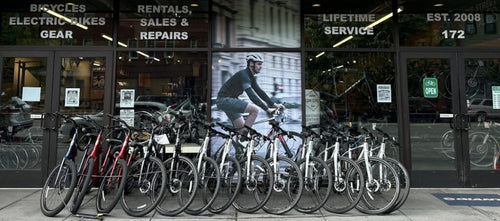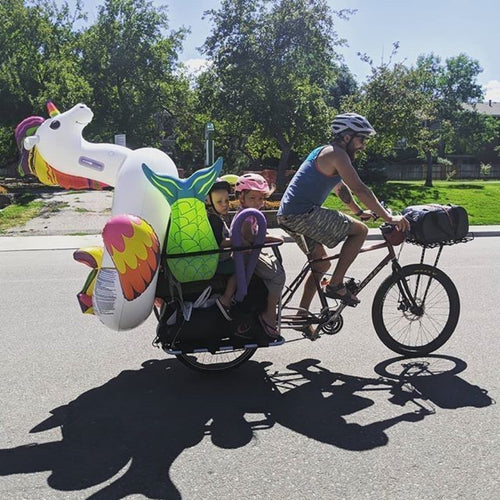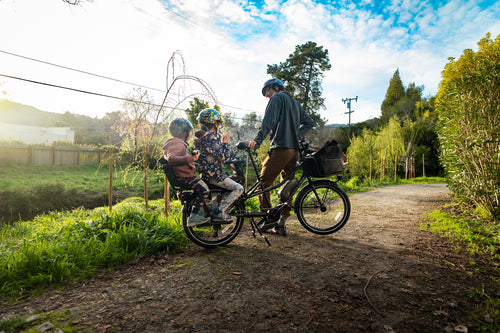Insights from experienced bike bus families on creating safer, more connected school commutes
Back-to-school season is here again and many families are reconsidering their morning routines, looking for ways to make the daily school commute more meaningful, sustainable, and fun. Enter the "bike bus" – a growing movement that's transforming how kids get to school while building stronger communities along the way.
 Bike busses empower kids to take a lead in their own transportation
Bike busses empower kids to take a lead in their own transportation
To help families understand the power and potential of bike buses, Xtracycle tapped two experienced bike bus community members who have firsthand experience with the joys and logistics of group cycling to school.
Phil Yip is a bike dad, licensed cycling instructor, and friend of Xtracycle who lives in Oakland, California, riding with his daughter to school every day and organizing weekly bike bus rides.
Maureen Burke is a mom of two in Berkeley, California, and a member of the Thousand Oaks School Bike Bus, as well as a staff contributor to 510 Families, who joined her daily bike bus in 2024.
Q: What are the benefits of a bike bus for kids and families?
Phil: The benefits are really incredible when you think about the fact that you're basically accomplishing the same task: getting your kid to school.
- Exercise: Kids get healthy physical activity in the morning, which has been shown to lead to better educational outcomes.
- Climate action: Our kids will disproportionately feel the effects of our past actions when it comes to climate change. Sometimes it feels like there's not much you can do, but biking to school lets kids and parents take real, direct climate action that reduces carbon emissions.
- Social activity and friendships: I've seen lots of friendships form during our bike bus rides. Cycling together allows for fun and positive social interactions, and this all happens during the simple act of just getting to school.
- Cycling benefits the community: This one surprised me a bit. When you ride a bike on the same route every day, you start to see familiar faces. You're outside, unenclosed, and you're moving at a speed where you can say hello and have positive interactions with others in your community. We see a bunch of "regulars" who we say hi to every time we pass by.
- Safety: There is power in numbers! It's a lot easier to notice a group of people than just one (smaller) person! But fundamentally, compared to driving an automobile, bikes are quieter, don't pollute the air, and are less dangerous to those around us. This all makes our surroundings much more pleasant.
 Bike busses bring all bikes together
Bike busses bring all bikes together
Q: How did you start bike bussing?
Phil: We don't own a car, and so we were planning to bike to school from the start. I had wondered if other parents were also biking to school with their kids. I started the Bike Bus after reaching out to our local Safe Routes to School chapter (Alameda County SR2S in my case) and seeing information about possible programming and volunteer opportunities.
Maureen: We joined our bike bus as regulars in August 2024. The bike bus was established a year or two before we joined by two local families.
Q: How many times per week/month do you organize bike bus rides?
Phil: We currently run our bike bus every week but try to do a larger one with other members of the community once per month.
Maureen: We ride every school day morning. My kids and I make it an effort to bike to school, though we take a day off if the roads are too wet from rain.
 The Thousand Oaks School Bike Bus rides on Bike to Wherever Day
The Thousand Oaks School Bike Bus rides on Bike to Wherever Day
Q: What ages do you see on your rides? Is it a mix of kids biking themselves and family bikes (cargo bikes, trailers, kid seats)?
Phil: There's a good range. Most kids in 1st and 2nd grade and older are riding their own bikes. Many younger kids are on cargo bikes. Usually the kids are big enough to not fit in the smaller kids seats anymore and instead sit on the back of a mid or long-tail. One of our kids rides on a trailer bike and is towed by their mom.
Maureen: Our bike bus has elementary-aged students, little siblings heading to daycare, and parents. Most families use cargo e-bikes because our route travels up a steep hill. On Wednesdays, most kids ride their own bikes alongside parents. I'm always so proud to see them pedal up the hill and enjoy the blissful feeling that comes from biking.
Q: How does riding in the bike bus contrast with your school commute before the bike bus started?
Maureen: Prior to joining our bike bus, we drove, walked with a stroller, or biked with a trailer on our own. There wasn't much consistency to how we traveled to school and it made our mornings a little chaotic. The bike bus has been helpful for keeping our morning routine steady. My kids get more fresh air to start their day, I get a little exercise, and we all benefit from the community of our bike bus. We are constantly on time for school and my return home is always faster than driving. So many wins!
 Maureen and her daughters tried multiple cargo bikes before finding the perfect fit
Maureen and her daughters tried multiple cargo bikes before finding the perfect fit
Q: When you started riding a cargo bike, what got you interested and what was the learning curve like?
Maureen: It's common to see families traveling by cargo e-bike in my neighborhood. It seemed like an enjoyable mode of transportation for kids and parents alike. Some friends had cargo bikes and really spoke highly of them. After a test ride, I chose an Xtracycle Swoop for its large cargo capacity and lower-center of gravity design. It took us about a week to find our flow with the bike, whether it was the kids climbing aboard or me mastering turns. Now, we use the bike over the car for most local outings or errands. It often streamlines our commute because I don't need to deal with buckling seatbelts, finding parking, among other things that had been related to traveling by car.
Q: Any advice for cargo-curious parents?
Maureen: Talk to other families who cargo bike. They will share their experiences (spoiler alert: so many upsides). Take a test ride. One ride with your kids will fill everyone with so much delight, you'll be riding home on your new cargo bike!
Q: What would you tell families looking to start riding in a bike bus (or starting one)?
Phil: I'd say generally the keys are to ride regularly, let people know you're doing it, and find a calm route. That last piece is something that a lot of departments of transportation need to work on. Schools are centerpieces of communities and our communities would all benefit from infrastructure that makes it easy for people to walk and bike to school.
Your community may have a local bike advocacy organization that can help. Here in the Bay Area we are lucky to have several: Bike East Bay, San Francisco Bicycle Coalition, Marin Bicycle Coalition, among others.

Biking builds community! Bay Area families join a Cargo Bike Party ride
Additionally, if you live in a large enough county, town or city, it probably has a county or municipal department of transportation. Try to meet your local leaders face-to-face and advocate for the change that you want to see to make everyone's cycling experience better. Start with your school's PTO or your district administration team as well. A great resource is Sam Balto of Bike Portland who has created an excellent guide.

